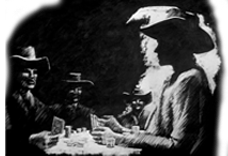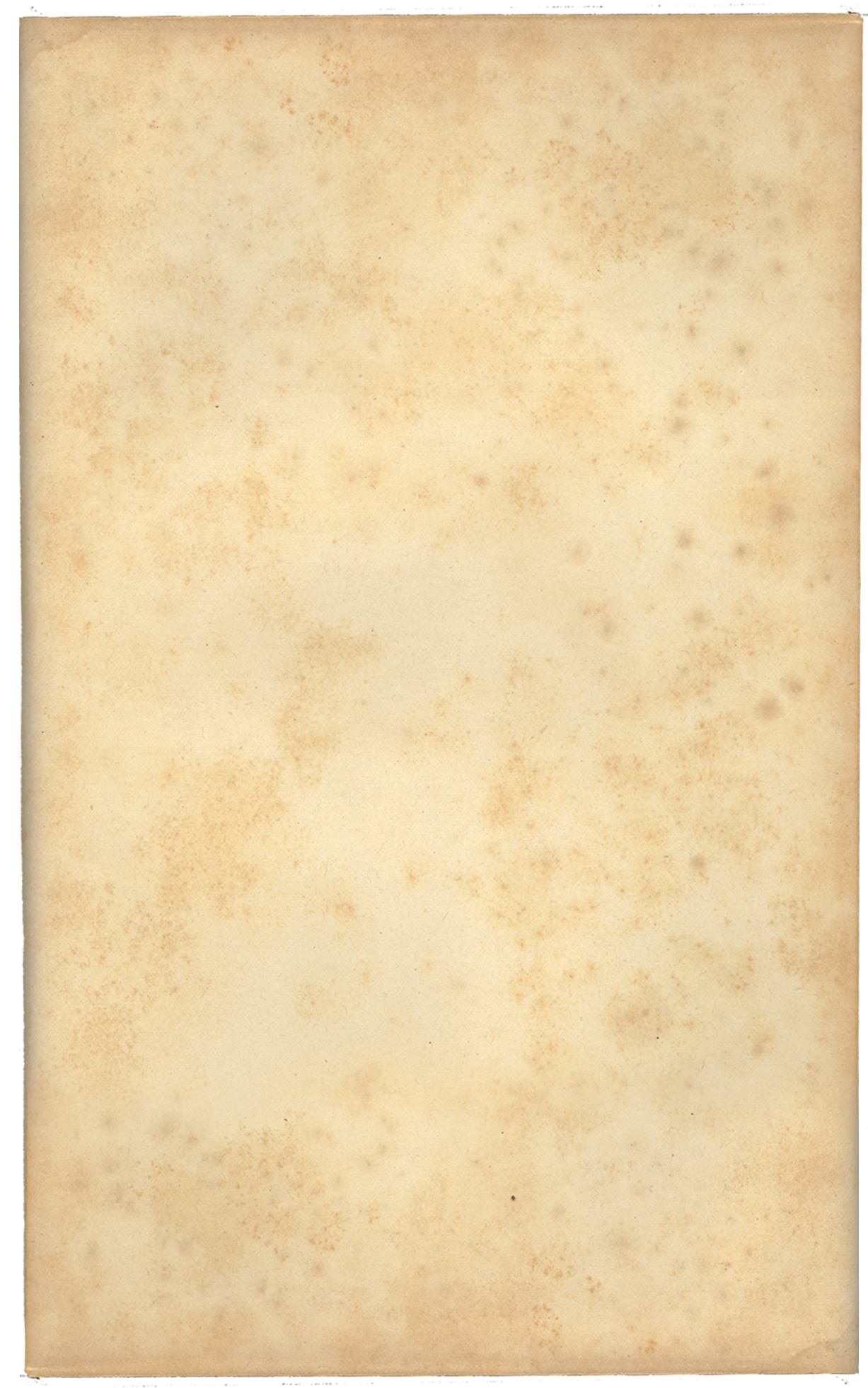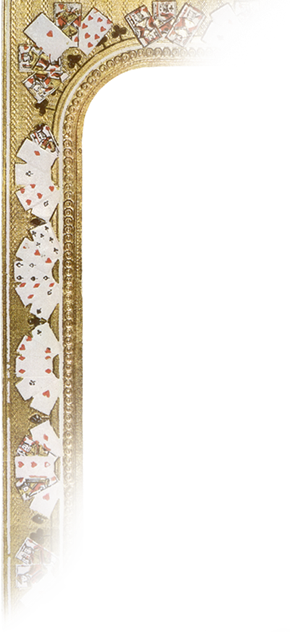





Some things in "Trail West to Fury"
are wild as the wind in Oregon, such as:
The strangest thing in "Trail West to Fury" by far is the Maverick Brothers' plan to settle down after the Civil War and raise cattle. This is, in a word, shocking. Bret and Bart's old Pappy could not have raised his two boys to ever consider work, let alone hard work, to earn a living. He would disown them for the very idea.
Yet, raise them he did. And if we are to believe anything in this story, we must accept that he raised them in Little Bend, Texas, where we know they grew up, and where the townsfolk knew and respected the Mavericks as "Texans from way back."[1]
According to Bret, his and Brother Bart's education began "practically on Pappy's knee." When they were less than ten years old, Pappy took them to a saloon in El Paso. He told them clearly, "Boys, take a good look. This is what's known as gambling. Stay away from it. In games like this you haven't got a chance. Remember as long as you live—stick to poker."[2]
So how did they fall so far from the tree by the time they returned home after the war? We have a clue from Bret when he tells Laura Miller, "We've been away for five years. We've been working for somebody else and fighting for somebody else. We'd like to work for ourselves now. And fight for ourselves."[1] It seems a reasonable statement for anyone, given what they've been through. That is, for anyone but a Maverick.
And what's all this about fighting for themselves? If there's one thing a Maverick avoids more than work, it's danger. So what's going on here?
In April of 1862, the Confederacy passed a conscription law, confirming that all white males between the ages of 18 and 35 were liable for military service. Bret would have been just turning 22, and Bart would have been 20. How patriotic the Maverick boys actually felt is unknown, but the law would have compelled them to enlist. Of this, we only know Pappy's parting words to them: "If either one of you comes back with a medal, I'll beat you to death."[3]
Bret tells Laura Miller that after five years of working for someone else and fighting for someone else, he and Bart want only to work and fight for themselves.[4] Perhaps they grew up somewhat during their years of fighting Yankees and Indians. But the urge to work a cattle ranch will be short-lived.
But where did the Maverick spread itself come from? It's hard to believe Pappy would have left a ranch to his boys. If they had grown up on a cattle ranch, how could they also have been raised by such a shiftless fellow as Beauregard Maverick, and then want to return after abandoning him to fight a war? From all we know of Pappy, despite his famous surname, we must assume he never wanted anything to do with a ranch or working cattle in any way.
In fact, Pappy is apparently no where in Little Bend when the boys return. We learn in "Pappy" he has been living in eastern Texas and spends much of his time across the Sabine River on the Louisiana side.[5] This seems more like the Pappy we have heard about. So who left a ranch to Bret and Bart? There are three possibilities:
The boys' Uncle Bentley Maverick, Pappy's brother, was very close to the boys. But he and Brother Beauregard, like brothers Bret and Bart, were two peas in a pod.[5] It seems unlikely that Bentley would have been different enough from his brother that he would have had any honorable desire to see his nephews embrace the kind of life demanded of a cattle ranch. He was as much like Pappy as Bart was like Bret.
Uncle Micah Maverick was a businessman. Years later, he would bequeath his Maverick Line to Bret and Bart in his will, in the hopes the boys will run the business as he did and earn an honest living. Of course, this won't work out to Uncle Micah's hopes,[6] but it does reveal another Maverick to be quite unlike Beauregard and Bentley. But the Maverick Ranch seems to have been abandoned since Bret and Bart were away during the war. A responsible businessman like Uncle Micah would probably not have been involved in such a neglected enterprise, or would have provided for its upkeep while the boys were away.
But there was Samuel Augustus Maverick, Texas lawyer, statesman and land baron, not to mention a signer of the 1836 Texas Declaration of Independence. He and his family were instrumental in the eventual creation of Texas as we know it today. He held vast grazing lands in Bexar County that he fully intended as a legacy to his surviving relatives, should they want it. He himself was hardly a rancher. He spent his interests in politics and law, leaving the business of managing his herds to others. His own indifference to herding cattle led to the now-common term "maverick," originally meaning an unbranded steer. Historically, Sam was the first Maverick to come to Texas, and to fall in love with it.[7] It is very likely he was a cousin Beauregard's southern line of the family and enticed them to come to Texas. Not only would it explain the dormant ranch during the war years, but also the comment of the Little Bend understanding that "Mavericks are Texans from way back."
So we conclude that Bret and Bart's spread was a gift in holding from Samuel Maverick himself, of which the boys fully intended to take advantage. But the fateful gunfight in Little Bend and the disappearance of the Tall Man led to the Maverick Brothers' exile from Texas and their enterprising plans. As they both stated later, they came to hope they would never find the Tall Man so they wouldn't be tempted to return to their ranch and "settle down."[1] It must have been a happy day in the Maverick clan when the boys proudly re-embraced their Pappy's philosophy and spread its wisdom whenever they could.
The Denver-Cheyenne and Laramie Line
Little Bend, Texas is 700 miles southeast of Denver, which seems a long way to be advertising this stage line.
Until the Tall Man is found, Bret and Bart can never safely return to Texas, due to Jessie Hayden's deposition of murder against them there.[1] Yet the Saga is replete with stories of them freely traveling into, out of and through Texas without any such concern, or even mention of their wanted status.
It could be assumed that, since the Union Army was the peace-keeping force at the time of the killings, the Mavericks' exile might only be in force until such time as the Army returned control of Texas to itself in 1876. But Hayden's deposition was documented with the San Saba County Attorney's office. Such charges would have remained on the books regardless of who was running the state.
But Bret easily travels into Texas as early as May of 1872. So we must reason that sometime between the Mavericks' telling of their story in August of 1871 and May of '72, either the Tall Man was found, or their innocence was otherwise determined. The Saga never reveals the end to that story.
Disappearing witnesses
People seem to disappear just when Bret and Bart want to talk to them the most.
Laura Miller from Jessie Hayden's general store
Bret: Thanks for your help, Lieutenant.
Union Army Lieutenant: Don't thank me, Mr. Maverick. The young lady is... she's gone!
The Tall Man from outside the Cattlemen's Hotel
Bart: We'd be obliged if someone would tell the Army boys. We're on our way to the Miller Ranch.
Bret: This man saw the whole thing. What happened to him?
At least Laura Miller left a note.[1]
When Laura Miller tells Bret and Bart the Union Army Lieutenant is looking for them for killing Hayden's men, Jim Hazlit suggests they had "better git." Laura tells them they can join the cattle drive at the New Mexico border.[1]
Considering the drive wouldn't be able to reach the New Mexico border for a full month,[8] that seems like a long time. Perhaps Laura's suggestion was assuming the Union Army's jurisdiction in a Texas murder only reached as far as the border, and the Mavericks could wait for them there. But it would have been strange to sacrifice her trail bosses so easily for nearly half the drive, considering what she went through to get them. Especially taking into account the majority of the Comanche trouble could be expected before reaching the border. It's lucky that the Union Army gave up their search for the Mavericks in less than a week and Bret was able to join the herd so quickly.[1]
In the Dell Adaptation, Bart informs Bret that Hayden has taken the Dawson Trail to avoid Pecos River flooding which, according to Bart, is a longer route but runs alongside the Pecos all the way to Adobe.[8] But the headwaters of the Pecos are northeast of Santa Fe, nearly 200 miles from the Arizona Territory border, further still from Fort Adobe itself.
In actuality, the Dawson Trail travels north along the Brazos River from Fort Belknap, Texas to Doan's Crossing at the Indian Territory border, then north to Dodge City, Kansas, and finally west up the Arkansas River to Pueblo in the Colorado Territory. This would certainly avoid the Pecos flooding, but would never get the Hayden drive to Fort Adobe before Miller. It would, however, be a possible route for the Tall Man's wagon train, or some of its scattered wagons, into Colorado Territory.
Bret tells Dandy Jim that "we were only two days from Fort Adobe when we took our first real break."[1] This seems strange after being on the trail for ten weeks,[7] especially when they were now racing the Hayden drive and "counting time by the hour."[1] Perhaps Bret didn't mean it was their first real break since the beginning of the drive, but only from the moment they began racing for Fort Adobe in earnest.

ABOVE: A seemingly out-of-place stage line advertisement hangs on Jessie Hayden's general store wall as Bret, the Union Army Lieutenant and Bart wonder what happened to Laura Miller.[1]


SOURCE REFERENCES
01. Maverick, Trail West to Fury (1958), Warner Bros. Pictures, Inc.
02. Poker According to Maverick (1959) Dell Publishing Company, Inc.
03. Maverick, Day of Reckoning (1958), Warner Bros. Pictures, Inc.
04. Maverick, Trail West to Fury (1958), Dell Publishing Company, Inc.
05. Maverick, Pappy (1960), Warner Bros. Pictures, Inc.
06. Maverick, The Maverick Line (1960), Warner Bros. Pictures, Inc.
07. Turn Your Eyes Toward Texas: Pioneers Sam and Mary Maverick, Paula Mitchell Marks (1989), Texas A&M University Press
08. A Chronology of Trail West to Fury, Maverick Trails
Home | The Maverick Saga | Trail Maps | Chronology | Maverick Lore | Production | The Inside Straight | Contact Maverick Trails
Maverick Trails is not endorsed, sponsored or affiliated with Warner Bros. Entertainment, Inc. or the Maverick franchise.
Maverick™ and its various marks are trademarks of Warner Bros. Entertainment, Inc., © 1957, 1994
©2014, 2015, 2016 Maverick Trails
